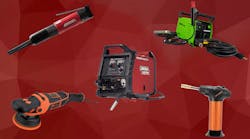Developed more than 50 years ago, plasma cutting has come a long way. With system size and price having been on a downslide for years, units that once weighed more than 50 lbs. and $2,500, now weigh less than 20 lbs. and $1,000, providing both affordability and practicality. Additionally, some smaller, more portable plasma cutting systems are now self-contained and can run off any 110V circuit.
Although plasma cutting is one of the most highly recognized and applicable cutting processes, it is imperative to use safety and precaution before starting your cut. Utilizing all the knowledge, tips and techniques acquired will allow for a productive plasma experience.
How Does It Work?
Many different gases can be used as plasma, including air, oxygen, argon-hydrogen and nitrogen. Once the pressurized gas is heated to an extremely high temperature, it becomes ionized and electrically conductive. At this point, the gas reaches the fourth state of matter and is considered to be plasma. The induced plasma stream carries the electrical current to the work piece and the intense heat melts the material. The molten metal is then blown away by the plasma stream. The result is a cut or severed material.
The intense heat of the plasma arc, around 40,000 degrees F, results in a cut that is clean with little or no dross. Done properly, the process usually requires very little rework or cleanup. The heat also allows the arc to burn through most surface coatings such as paint and rust, so less preparation work is needed. Plasma can cut ferrous and nonferrous metals with little or no heat-affected zone. This is especially useful when cutting thin material such as duct work as it will not warp or bend.
Making the Most of Plasma Cutting
Basic questions: How thick is the material to be cut? What level of cut quality do I require? What type of material am I cutting? What is my primary input power? Knowing the answers to these questions will help your local distributor guide you in the right direction.
Basic terminology: severance, pierce, "recommended cut" and "rated to" refer to a machine’s cutting capabilities. Amperage draw, input voltage and maximum amperage output refer to the amount and type of power used and the amount of power transferred to the material being cut.
Safety and Troubleshooting Tips
The appropriate PPE (personal protective equipment) is required to protect hands from heat and eyes from the intense light of the plasma stream.
Supplying clean, dry air and keeping the consumables in good condition will help to ensure optimal performance day in and day out. Moisture will reduce the effective life of the consumables, while air contaminants will clog filters and reduce flow – both will affect the unit’s efficiency. The addition of a roll bar is a simple way to protect all the gauges and connections from being damaged in a fall.
Product Features
Quick disconnects will allow damaged torches to be replaced quickly or allow lead extensions to be added so that work can be done up to 100 feet away from the power supply.
Some of the more advanced models aid in troubleshooting with onboard diagnostics that indicate what type of setup or error condition is occurring. For example, if incoming air pressure drops below an acceptable level for optimal performance, the unit will shut down and an LED will flash a low-pressure-condition message on the front panel. Or, if the consumable components are not installed correctly, another LED will show a parts-in-place error. Units have become more user-friendly in recent years with the focus being on uptime and ease of use.

